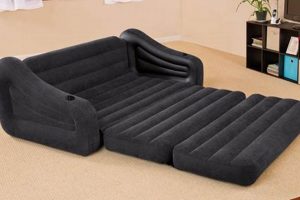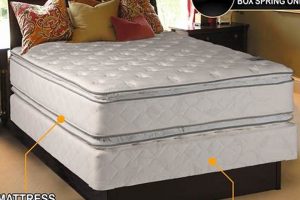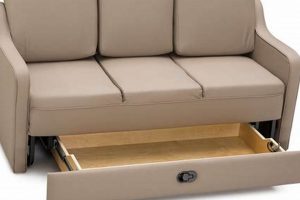Discolorations observed on mattresses resembling rust are often indicative of the presence of bed bugs. These stains are not, in fact, rust, but rather dried excrement composed primarily of digested blood. The dark, reddish-brown spotting occurs when bed bugs deposit fecal matter onto the mattress surface after feeding. For example, small clusters of dark spots near seams or tufts are a common sign of infestation.
Identifying and correctly interpreting these markings is crucial for early bed bug detection. Prompt identification can facilitate swift implementation of control measures, preventing widespread infestation and minimizing potential health concerns associated with bed bug bites. Historically, such staining has served as a key visual indicator, predating more technologically advanced detection methods, and remains a readily accessible diagnostic tool for both professionals and individuals.
The following sections will delve further into the characteristics of these stains, explore methods for differentiating them from other types of mattress discoloration, and outline effective strategies for addressing bed bug infestations and removing associated residue from affected surfaces.
Guidance Regarding Mattress Discoloration Associated with Bed Bugs
This section offers practical guidance concerning the identification and management of mattress staining linked to bed bug activity. Diligent observation and appropriate action are essential for effective control.
Tip 1: Conduct Regular Inspections: Routinely examine mattress seams, tufts, and crevices for any signs of dark spotting. Consistent monitoring increases the likelihood of early detection.
Tip 2: Differentiate Stains Accurately: Ensure observed marks are indeed bed bug excrement and not other substances like mold, mildew, or food stains. Bed bug stains typically appear as small, concentrated dark spots.
Tip 3: Utilize a Magnifying Glass: A magnifying glass can aid in discerning the specific characteristics of the stains, such as their size and texture, particularly when dealing with light infestations.
Tip 4: Check Surrounding Areas: Extend the inspection beyond the mattress to include bed frames, headboards, and nearby furniture. Bed bugs often harbor in close proximity to their feeding source.
Tip 5: Document Findings: Maintain a record of any discoloration or suspected bed bug activity, including photographs. This documentation can be valuable when consulting with pest control professionals.
Tip 6: Consider Professional Assessment: If uncertainty persists regarding the nature of the stains, seek a professional pest control inspection. Experts can accurately identify infestations and recommend appropriate treatment strategies.
Tip 7: Isolate the Infested Mattress: If an active infestation is confirmed, consider encasing the mattress in a bed bug-proof cover to prevent further spread. This measure helps contain the problem while treatment options are explored.
Adherence to these recommendations can significantly improve the likelihood of detecting and managing bed bug infestations at an early stage, minimizing potential disruptions and associated costs.
The subsequent sections will provide information about effective cleaning techniques for removing mattress stains and preventive measures to discourage future infestations.
1. Identification
Accurate identification of mattress staining is paramount in determining the presence of bed bugs. Mistaking these signs for other types of discoloration can lead to delayed intervention, exacerbating the infestation and potentially increasing health risks.
- Visual Characteristics
Bed bug stains typically present as small, dark, and often reddish-brown spots. They may appear smeared or clustered, especially along mattress seams, tufts, or edges. These visual cues are critical for distinguishing them from other stains caused by spills, mold, or general wear and tear.
- Distribution Patterns
The pattern in which the stains are distributed can offer further insight. Bed bug stains often occur in linear arrangements or small clusters, reflecting the movement of bed bugs along seams or their harborage sites. A uniform distribution across the entire mattress surface is less likely to be indicative of bed bug activity.
- Confirmation Methods
While visual inspection is a primary means of identification, confirmation can be achieved through additional methods. This includes the use of a magnifying glass to examine the stain’s texture and composition, as well as inspecting the surrounding areas for other signs of bed bugs, such as shed skins or live insects. Use of specialized detection tools may provide additional confirmation.
- Differential Diagnosis
It is imperative to differentiate bed bug stains from other potential sources of mattress discoloration. This requires careful consideration of the stain’s appearance, location, and any associated odors. Ruling out other possibilities, such as mold, mildew, or food stains, is essential for accurate identification and appropriate action.
The facets of accurate stain identification contribute directly to the early detection and effective management of bed bug infestations. Early identification, achieved through careful observation and, when necessary, professional assessment, provides a foundation for swift intervention, limiting the scope of the infestation and mitigating potential health and economic impacts.
2. Composition
The characteristics of discolorations stem directly from their fundamental constituents. These stains are not rust, a product of oxidation. Instead, their composition is primarily digested blood excreted by bed bugs after feeding. The dark, reddish-brown hue originates from the metabolized hemoglobin within the blood meal. Minute quantities of chitin, derived from the insect’s exoskeleton, and other waste products may also be present. The understanding of this composition is important because it helps differentiate such marks from other substances that stain mattresses. For instance, a spill of iron-rich liquid might produce true rust stains, while fungal growth would exhibit different colors and textures. The key distinguishing factor is that the aforementioned stains are a direct result of bed bug activity.
Analyzing the composition provides insights into effective cleaning strategies. Common household cleaners that target organic matter and blood-based stains are generally effective for removing these marks. However, complete removal can be challenging due to the tendency of the excrement to penetrate deep into mattress fibers. Real-world examples of unsuccessful attempts to clean these discolorations often involve using ineffective c
leaning agents or neglecting to treat the underlying infestation, leading to recurring stains. Professional cleaning services specializing in biohazard remediation may be required in cases of heavy infestation.
In conclusion, the composition of these stains provides crucial information for accurate identification and informed remediation strategies. Misunderstanding their nature can lead to ineffective cleaning efforts and a prolonged infestation. The link between composition and stain appearance is key to developing appropriate and targeted approaches for both stain removal and bed bug control. Further, the need for professional services may be necessary in some cases.
3. Location
The position of mattress discoloration is a critical factor in determining the likelihood of bed bug involvement. The distribution and specific placement of these stains can provide valuable clues regarding harborage areas and activity patterns of these pests.
- Seams and Crevices
Bed bugs are thigmotactic, meaning they prefer tight spaces. Consequently, mattress seams, tufts, and crevices provide ideal harborage. Discoloration concentrated in these areas is highly suggestive of bed bug activity, as the insects often defecate shortly after feeding in these protected locations. Real-world examples include dark spotting along the edges of the mattress or within the folds of sewn fabric.
- Proximity to Sleeping Areas
Bed bugs are most active during the night when hosts are sleeping. Marks found in close proximity to where individuals typically lie are more likely to be associated with bed bug infestations. The stains will typically show a higher frequency near the head and torso regions of the mattress, reflecting where humans are most likely to spend their time during the hours of rest.
- Adjacent Furniture and Structures
Inspection should extend beyond the mattress to include nearby bed frames, headboards, and other furniture. Bed bugs often establish harborages in these locations and may leave stains on these surfaces as well. The presence of similar discolorations on adjacent items strengthens the suspicion of an active infestation and suggests its broader scope.
- Encasements and Barriers
The location of stains on or around mattress encasements can provide valuable information. Stains on the exterior of an encasement indicate its effectiveness in containing the infestation. Conversely, stains observed beneath or inside an encasement suggest a breach in its integrity or a pre-existing infestation prior to its installation.
These facets of location collectively contribute to a comprehensive understanding of bed bug activity within a sleeping environment. By carefully examining the placement of mattress stains, one can more accurately assess the likelihood of an infestation and implement targeted control measures. Further investigations should incorporate other indicators, such as live insects or shed skins, for conclusive diagnosis.
4. Infestation Indicator
The presence of mattress discoloration serves as a salient indicator of potential bed bug infestation. Evaluating the characteristics and patterns of these markings provides crucial evidence for determining the need for further investigation and targeted intervention.
- Early Detection Signal
These stains often represent one of the earliest detectable signs of bed bug activity. The appearance of small, dark spots on the mattress may precede other indicators, such as the observation of live insects or bed bug bites. Early identification allows for prompt action, potentially preventing a full-blown infestation. Consider a scenario where a property manager regularly inspects mattresses in rental units. Noticing these discolorations during routine checks can trigger immediate treatment protocols, avoiding larger infestations that would be more costly and disruptive to resolve.
- Population Density Proxy
The quantity and distribution of stains can serve as a proxy for estimating the size and density of the bed bug population. A higher concentration of marks generally suggests a more established and widespread infestation. A family noticing a gradual increase in the number of stains over several weeks might infer a growing bed bug population and the need for professional pest control services.
- Harborage Area Mapping
The location of stains helps to map potential harborage areas within the sleeping environment. A concentration of marks along mattress seams and tufts suggests that bed bugs are actively using these areas for shelter and reproduction. A pest control professional could use this information to target treatment efforts directly to these harborage sites, maximizing the effectiveness of the intervention.
- Treatment Efficacy Assessment
Monitoring the presence or absence of stains after treatment provides valuable insight into the efficacy of pest control measures. A reduction or elimination of staining indicates successful eradication or control of the bed bug population. Conversely, persistent staining suggests that further treatment or a modified approach may be necessary. Landlords could use this data to determine the need for further applications.
In summary, the presence of mattress discoloration functions as a multifaceted indicator of bed bug infestation. Recognizing the significance of these marks, both in terms of early detection, population estimation, and treatment assessment, is vital for proactive management and effective resolution of bed bug problems. This serves as an important method to assess effectiveness and to help identify areas that may need further attention.
5. Cleaning Challenges
The removal of mattress discolorations, frequently indicative of bed bug infestation, presents distinct challenges that necessitate careful consideration and specialized cleaning techniques. The organic nature of these stains, coupled with the porous composition of mattress materials, complicates effective remediation.
- Stain Penetration
The excrement deposited by bed bugs readily penetrates mattress fibers. This penetration makes surface cleaning alone ineffective, as residual staining often remains embedded within the material. The deeper the stain penetrates, the more difficult it becomes to fully eradicate. Attempting to clean with surface agents often leaves a shadow or discolored ring.
- Material Sensitivity
Mattresses are constructed from a variety of materials, including cotton, foam, and synthetic fibers. Each material reacts differently to cleaning agents, and aggressive cleaning methods can cause damage, discoloration, or degradation. Abrasive cleaners can permanently damage the fabric. Bleach can discolor and weaken some mattress materials. This complicates the stain removal process.
- Disinfection Requirements
Beyond stain removal, addressing mattress contamination requires disinfection to eliminate any residual pathogens or allergens associated with bed bug activity. H
owever, many disinfectants are not suitable for use on mattresses due to potential toxicity or material compatibility issues. Steam cleaning can kill bed bugs and sanitize the mattress, but may not remove set stains. - Re-infestation Risk
Cleaning a mattress without addressing the underlying bed bug infestation is futile. Even if the stains are successfully removed, bed bugs will continue to feed and excrete, resulting in recurring discoloration. Effective cleaning must be integrated with comprehensive pest control measures to prevent re-infestation and the re-emergence of stains.
These cleaning challenges highlight the complexity of addressing mattress discolorations associated with bed bugs. Effective remediation requires a multi-faceted approach that considers stain penetration, material sensitivity, disinfection requirements, and the overarching need for comprehensive pest control. Failure to address these factors will likely result in incomplete stain removal, material damage, and a persistent infestation.
6. Preventative Measures
The relationship between preventative measures and the absence of mattress staining is direct and significant. Implementing proactive strategies to prevent bed bug infestations inherently reduces the likelihood of observing the characteristic stains on mattresses. These stains, being a byproduct of bed bug feeding and subsequent excretion, only manifest when an infestation is present. Therefore, the effectiveness of preventative actions can be gauged, in part, by the absence of these visual indicators. For instance, consistent use of mattress encasements creates a physical barrier, preventing bed bugs from colonizing the mattress and, consequently, eliminating the source of mattress stains. Similarly, regular inspection of luggage and belongings after travel minimizes the introduction of bed bugs into the home environment, reducing the chances of subsequent staining. The practical significance of this understanding lies in the ability to correlate the application of preventative measures with a tangible outcome: a clean, stain-free mattress.
Further analysis reveals that the type and consistency of preventative measures directly impact their efficacy. Simple actions, such as vacuuming frequently and decluttering living spaces, disrupt potential harborage sites and limit bed bug populations. More comprehensive strategies, such as professional pest control treatments for multi-unit dwellings or heat treatments for heavily infested items, offer a higher degree of protection. A homeowner who diligently follows a routine of vacuuming, encasing mattresses, and regularly inspecting for signs of bed bugs is far less likely to encounter mattress staining compared to someone who neglects these precautions. This highlights the importance of a multi-faceted approach, combining various preventative tactics to create a robust defense against bed bug infestations. Furthermore, educating oneself and others about bed bug prevention is critical for minimizing the risk of introducing and spreading these pests.
In conclusion, the connection between preventative measures and the appearance of bed bug-related mattress staining is clear. Proactive efforts to prevent infestations directly translate to a reduced likelihood of observing these telltale signs. While challenges may arise in consistently implementing these measures, the practical benefits of a clean and pest-free mattress, devoid of such discolorations, underscore the importance of prioritizing bed bug prevention strategies. Furthermore, recognizing that the absence of staining serves as a positive indicator of successful preventative action reinforces the value of these efforts in maintaining a hygienic and healthy sleeping environment.
Frequently Asked Questions
The following addresses common inquiries related to mattress discolorations potentially indicative of bed bug infestations. Accurate knowledge is crucial for effective identification and appropriate action.
Question 1: What exactly are these mattress stains referred to as “rust stains”?
These stains are not, in fact, rust. The dark or reddish-brown discolorations are the excrement of bed bugs, primarily composed of digested blood.
Question 2: How can mattress markings linked to bed bugs be distinguished from other types of stains?
Bed bug excrement typically appears as small, dark spots or smears, often clustered near mattress seams. Other stains, such as food spills or mold, will present different visual characteristics and distribution patterns.
Question 3: What steps should be taken upon discovering mattress discolorations suspected to be bed bug stains?
The mattress and surrounding areas must be thoroughly inspected for other signs of bed bug activity, such as live insects or shed skins. Consider professional pest control consultation for definitive identification and treatment options.
Question 4: Is it possible to remove these stains from a mattress effectively?
Complete removal can be challenging due to the stain’s penetration into mattress fibers. Cleaning methods targeting blood-based stains may offer some improvement, but professional cleaning services may be necessary.
Question 5: Will cleaning the mattress alone eliminate the bed bug problem?
Cleaning alone is insufficient. A comprehensive pest control strategy is essential to eradicate the bed bug infestation. Failure to address the underlying infestation will result in recurring stains.
Question 6: What preventative measures can be implemented to avoid future mattress discolorations from bed bugs?
Mattress encasements, regular inspections, and cautious travel practices are key preventative measures. Professional pest control services for multi-unit dwellings can also reduce the risk of infestation.
Accurate identification, comprehensive treatment, and proactive prevention are paramount in managing bed bug infestations and minimizing mattress staining.
The following section will explore additional resources and further steps for addressing bed bug concerns.
Conclusion
The preceding discussion has elucidated the characteristics, implications, and management strategies associated with bed bug rust stains on mattress. These stains, indicative of bed bug activity, necessitate accurate identification, comprehensive intervention, and diligent preventative measures. The complexities involved in stain removal and the potential for recurring infestations underscore the importance of a multi-faceted approach.
Effective control of bed bug infestations requires vigilance and informed action. Continued research and the implementation of best practices are crucial for safeguarding public health and ensuring habitable living environments. Proactive measures, including professional consultation and diligent monitoring, remain paramount in mitigating the impact of these persistent pests and their associated mattress discolorations.







